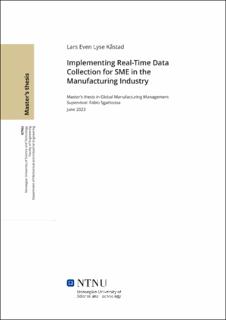| dc.contributor.advisor | Sgarbossa, Fabio | |
| dc.contributor.author | Kåstad, Lars Even Lyse | |
| dc.date.accessioned | 2023-10-10T17:19:58Z | |
| dc.date.available | 2023-10-10T17:19:58Z | |
| dc.date.issued | 2023 | |
| dc.identifier | no.ntnu:inspera:146717033:45340782 | |
| dc.identifier.uri | https://hdl.handle.net/11250/3095592 | |
| dc.description.abstract | Denne oppgaven tar sikte på å finne ut hvordan sanntidsdatainnsamling kan introduseres i små og mellomstore bedrifter. Å introdusere Industri 4.0-verktøy i SMB er utfordrende da verktøyene kan kreve betydelige investeringer og høy kompetanse. SMB har ofte en kortsiktig strategi og mener risikoen ved å implementere ny teknologi er for stor. Ved å samle inn data kan bedrifter opprettholde et konkurransefortrinn, få kontroll, bekrefte behov for forbedringstiltak eller bekrefte at tiltakene virker. Og at vitenskapelige studier viser at det å skaffe seg oversikt over prosessen gjennom datainnsamling er første skritt for å forbedre den.
Studien er utført i samarbeid med en SMB innen prefabrikkerte treelementproduksjonsindustrien. Gjennom casestudien er det illustrert hvordan sanntidsdatainnsamling kan implementeres. Det første trinnet i implementering av sanntidsdatainnsamling er å kartlegge fokusområdet. Det ble derfor gjennomført en litteraturstudie for å finne metoder for kartlegging. Neste steg er å kartlegge fokus området, i dette tilfellet en produksjonslinje, hvor verdistrømskartlegging ble utført. Det siste trinnet var å finne teknologier som kan samle inn data i sanntid.
Det ble funnet tre metoder for å kartlegge, verdistrømskartlegging, styringsmodellmetodikken og flytskjemametodikken. Metodene ble sammenlignet, og fordeler og ulemper ble tilegnet. Gjennom verdistrømskartlegging ble data fra produksjonslinjen samlet inn. Det ble utført en sammenligning av hvilke data som burde samles inn i sanntid. Litteraturstudien fant tre teknologier for å samle inn data i sanntid: RFID, smarte enheter og sensorer. Forslag til implementering av teknologiene i produksjonslinjen ble introdusert, og fordelene og ulempene ved forslagene ble gjennomført.
Resultater fra denne oppgaven bidrar til kunnskap om hvordan SMB kan introdusere Industry 4.0 ved å implementere sanntids datainnsamling. Oppgaven fokuserer på en bedrift i prefabrikkert treelementproduksjonsindustri men kan gjelde bedrifter og bransjer som opererer i lignende miljøer. For casebedriften Overhalla Hus har forskningen bidratt med innsikt i hvordan de kan introdusere Industri 4.0-teknologi. | |
| dc.description.abstract | This assignment aims to determine how real-time data collection can be introduced in small and medium enterprises. Introducing Industri 4.0 tools in SMEs is challenging as the tools can require significant investment and a high level of expertise. SMEs often have a short-term strategy and believe the risk of implementing new technology is too considerable. By collecting data, companies can maintain a competitive advantage, gain control, confirm the need for improvement measures or confirm that the measures are working. And that scientific studies show that obtaining an overview of the process through data collection is the first step in improving it.
The study has been carried out in collaboration with an SME within the prefabricated wooden element production industry. Through the case study, it is illustrated how real-time data collection can be implemented. The first step in implementing real-time data collection is to map the focus area. A literature study was therefore carried out to find methods for mapping. The next step is to map the area, in this case, a production line, where value stream mapping was conducted. The last step was to find technologies that can collect data in real-time.
Three methods were found to map, value stream mapping, the control model methodology and flowchart methodology. The methods were compared, and advantages and disadvantages were acquired. Through value stream mapping, data from the production line was collected. A comparison of which data to collect in real time was conducted. The literature study found three technologies to collect data in real-time: RFID, smart devices and sensors. Proposals for implementing the technologies in the production line were introduced, and the advantages and disadvantages of the proposals were carried out.
Results from this assignment contribute to knowledge about how SMEs can introduce Industry 4.0 by implementing real-time data collection. The assignment focuses on a company in the prefabricated wooden element production industry but may apply to companies and industries operating in similar environments. For the case company, Overhalla Hus, the assignment has contributed insight into how they can introduce Industry 4.0 technology. | |
| dc.language | eng | |
| dc.publisher | NTNU | |
| dc.title | Implementing Real-Time Data Collection for SME in the Manufacturing Industry | |
| dc.type | Master thesis | |
